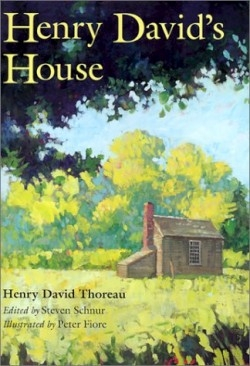Henry David's House
One hundred fifty-seven years ago, the author began his celebrated experiment in Concord, Massachusetts. “I went to the woods because I wished to live deliberately, to front only the essential facts of life, and see if I could not learn what it had to teach, and not, when I came to die, discover that I had not lived.” The editor has selected passages in which Thoreau chronicles his labor of love: he borrowed an axe in March of 1845, and built his own cabin in the woods along Walden Pond.
Each double-page spread moves the reader ahead one month. Thoreau meticulously charts the progress of construction and lovingly details the glories of nature. The illustrator’s full-page light-filled watercolor and oil paintings capture Thoreau’s simple yet eloquent text. In the lower right corner of each text page, Fiore marks the passage of the seasons with lush thumbnail images of nature (ducks upon an ice-laden pond, butterfly, water lily, apples, pumpkin, snow-covered berries). Readers may recognize Fiore’s impressionistic style from his illustrations for The Boston Tea Party (Holiday House, 1998), and Dear Willie Rudd (Simon and Schuster, 1993).
Editor Schnur has also written picture books emphasizing nature, like Autumn: An Alphabet Acrostic (Clarion, 1997) and Spring Thaw (Viking, 2000), as well as provocative middle-year novels emphasizing human nature and moral conflicts like The Koufax Dilemma (William Morrow, 1997) and The Shadow Children (William Morrow, 1994).
Schnur thinks that younger children (ages five through eight) will be able to identify with the philosophy of Transcendentalist Thoreau. In the Editor’s Note, he writes, “Thoreau forever changed the way we think about nature and our place in it.” This beautiful book can easily prompt a discussion with children about the “trappings” of modern life. What would daily life be like without computers, cell phones, and televisions? What would it be like to build a cabin by yourself with only an axe and nails? What would it be like to live in the woods? What can humans learn from nature? The answers elicited will surprise adults and open rich avenues for exploration.
Reviewed by
Peggy Beck
Disclosure: This article is not an endorsement, but a review. The publisher of this book provided free copies of the book to have their book reviewed by a professional reviewer. No fee was paid by the publisher for this review. Foreword Reviews only recommends books that we love. Foreword Magazine, Inc. is disclosing this in accordance with the Federal Trade Commission’s 16 CFR, Part 255.

